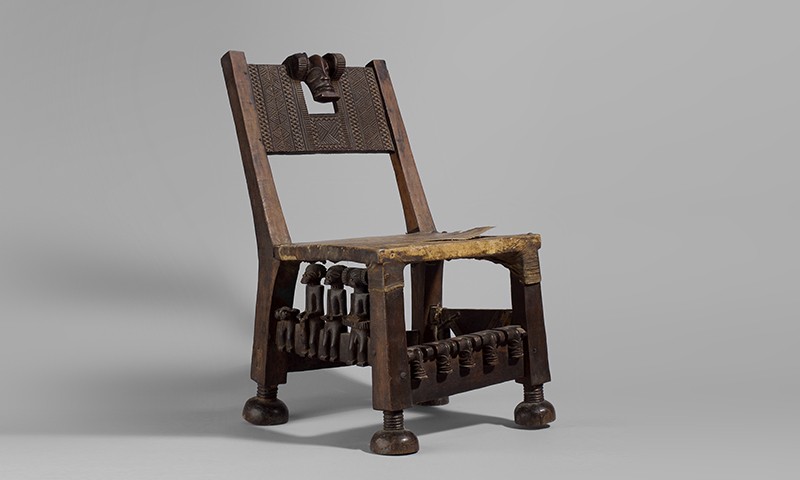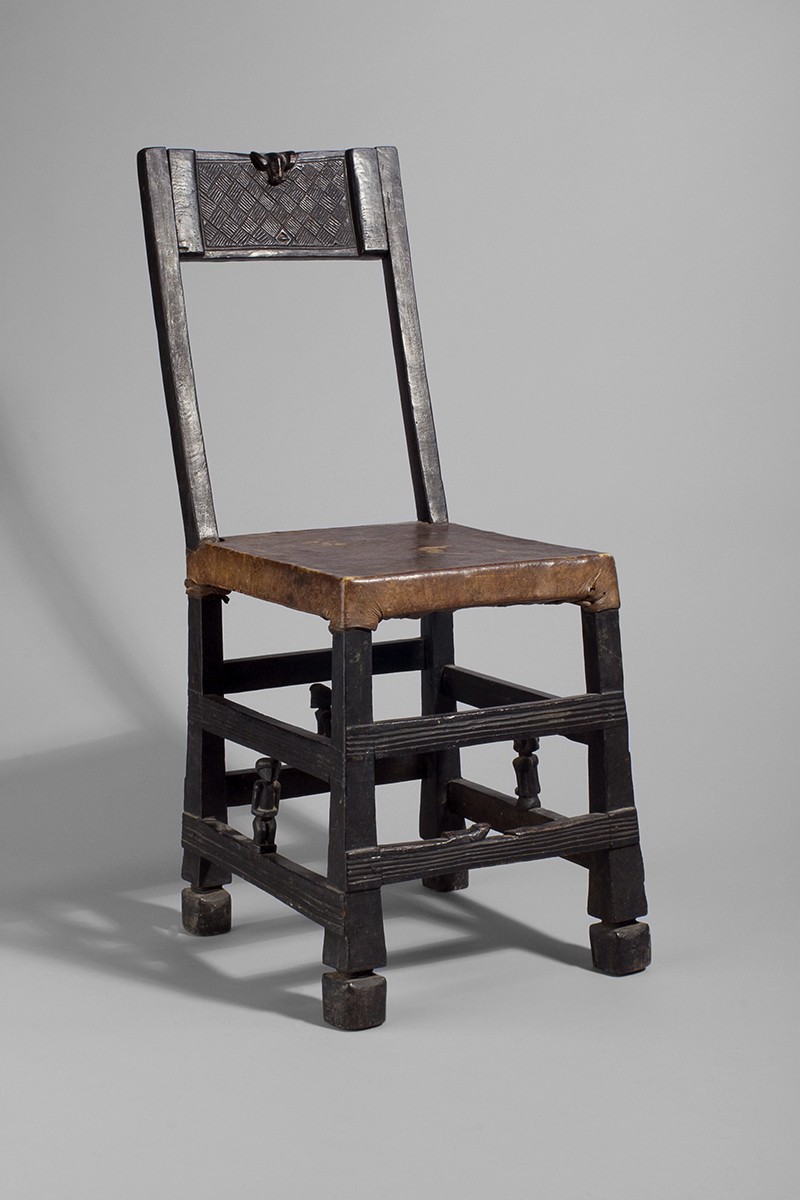 |
Chair (Ngundja), early 20th to mid Century
Chokwe culture; Angola
Wood, metal and leather; 19 1/2 x 10 1/2 x 13 in.
2007.4.55
Gift of the Roschen Family Trust |
Have a Seat
Driving to and from work, sitting at a desk, relaxing on the couch—we spend much of our time sitting down without paying too much attention to what we are sitting in. But as thrones, chairs have historically served as the literal embodiment of a country’s seat of power and can be very telling of a country's governmental system. Take the simple swivel chair used by the President of the United States compared to the gilded thrones monarchs reigned from in the middle ages as an example. The unique ngundja, the vernacular term for the chairs of the Chokwe people of Angola, the Democratic Republic of the Congo, and Zambia, speak volumes on the culture's ruling class. This post explores the history of these chairs, their design, and the importance of the decorations on the chairs.
Musical Chairs
Beginning in the 17th Century and intensifying over the latter half of the 18th Century, Portuguese traders began entering Chokwe territories in Angola by way of caravans. The history of the two peoples was a complicated one. As with so many of the other inland groups of west Africa, the Chokwe were ravaged by slavers working in the Atlantic slave trade until its abolition in the 1830s. Relations normalized thereafter as the Chokwe became suppliers of ivory, rubber and wax for Portugal, but the tension never truly dissipated. What the Chokwe did take from their interactions with westerners was their designs—not the least of which was from the chairs the Portuguese brought with them. Like many other Sub-Saharan groups, the Chokwe had previously used low wooden stools, often decorated with caryatids, for seating. The European style chairs were seen as a marked improvement and were quickly adopted by the tribal chiefs who could afford to commission them from wood carvers.
 |
Chair (Ngundja), early to mid 20th Century
Chokwe culture; Angola
Wood, metal and leather; 25 1/4 x 10 1/4 x 13 1/2 in.
2007.4.56
Gift of the Roschen Family Trust |
Socket to ‘em
The earliest chairs tended to be more stylistically similar imitations of those used by the Portuguese. They were often carved from single pieces of wood and were small relative to their European counterparts which were roughly the same size as the stools the Chokwe had used previously. It was not long though before the renowned craftsmen of the Chokwe picked up on the technique of socketing crossbars used by the Portuguese. With this technology, the individual pieces of the chair could be smaller, allowing for the overall size of the chair to match those used by Europeans. This appropriation of technology makes the Chokwe one of the few exceptions to the general rule that Sub-Saharan woodcarving is made from a single piece of wood. These chairs are affixed with iron nails, but the brass nails used on many of the other examples of Chokwe chairs would have been as rare as gold.
A Head of the Rest
The iconography of the Chokwe chairs began evolving as soon as the first chairs were created. This can range from the minor alterations seen on the taller of the two chairs, to the immensely decorated examples housed in other museum collections. As with many of the finer wood carved objects in the possession of chiefs, ngundja were more than just a comfortable place to rest one’s seat. They also served as prestige objects, which would show others the importance of the owner. The iconography of these chairs tends to speak to the aspirations and daily sights of a chief, and the importance of the individual figures depicted rises hierarchically as they approach the top of the chair. Typical figures resting atop the rungs of ngundja were generally engaged in some activity of daily Chokwe life: court figures dancing, musicians playing instruments, blacksmiths working bellows. Guardian caryatids may support the seat as chair legs. The backs of the chair tend to be unique combinations of geometric designs composed of individual designs which each bear names. At the middle-top of this chair back is the crux of the chair. In the case of both of the Bowers’ ngundja, this space is filled with Chihongo, an ancestral spirit who brings wealth and wears the distinctive headdress seen here. Considering his seated figure on the right support rung of the squatter chair, it is likely that all of the figures seen on this chair are ancestral, making the chair a unique counterexample to the general hierarchical structures of the chairs.
Text and images may be under copyright. Please contact Collection Department for permission to use. References are available on request. Information subject to change upon further research.



Comments